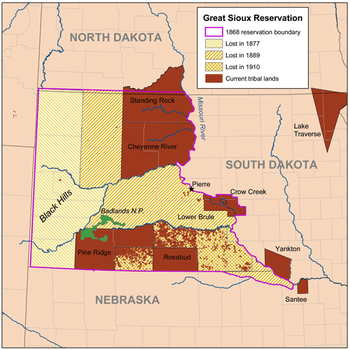Treaty of Fort Laramie (1868)


The Treaty of Fort Laramie (also called the Sioux Treaty of 1868) was an agreement between the United States and the Oglala, Miniconjou, and Brulé bands of Lakota people, Yanktonai Dakota, and Arapaho Nation[1] signed on April 29, 1868 at Fort Laramie in the Wyoming Territory, guaranteeing the Lakota ownership of the Black Hills, and further land and hunting rights in South Dakota, Wyoming, and Montana. The Powder River Country was to be henceforth closed to all whites. The treaty ended Red Cloud's War.
In the treaty, the U.S. included all Ponca lands in the Great Sioux Reservation. Conflict between the Ponca and the Sioux/Lakota, who now claimed the land as their own by U.S. law, forced the U.S. to remove the Ponca from their own ancestral lands in Nebraska to land in Oklahoma; it did not meet the needs of the Ponca, many of whom made their way back to Nebraska. Article 16 in the treaty specified in that in addition "the country north of the North Platte River and east of the summits of the Big Horn Mountains shall be held and considered to be unceded Indian territory,[...] no white person or persons shall be permitted to settle upon or occupy any portion of the same; or without the consent of the Indians first had and obtained, to pass through the same."
The treaty includes an article intended to "ensure the civilization" of the Lakota, financial incentives for them to farm land and become competitive, and stipulations that minors should be provided with an "English education" at a "mission building." To this end the U.S. government included in the treaty that white teachers, blacksmiths, a farmer, a miller, a carpenter, an engineer and a government agent should take up residence within the reservation. In the late 19th century, the federal government shifted from mission schools on reservations to establishing Indian boarding schools; the first was the Carlisle Indian Industrial School in Pennsylvania. Chief Manuelito sent his sons to this school, believing that it would help them eventually protect their freedoms.[2] Repeated violations of the otherwise exclusive rights to the land by gold prospectors led to the Black Hills War. Migrant workers seeking gold had crossed the reservation borders in violation of the treaty. Indians had attacked these gold prospectors and war ensued. The U.S. government seized the Black Hills land in 1877. It later broke up the Great Sioux Reservation into several reduced reservations.
More than a century later, the Sioux nation won a victory in court. On June 30, 1980, in United States v. Sioux Nation of Indians,[3] the United States Supreme Court ruled that the government had illegally taken the land. It upheld an award of $15.5 million for the market value of the land in 1877, along with 103 years worth of interest at 5 percent, for an additional $105 million. The Lakota Sioux, however, have refused to accept payment and instead continue to demand the return of the territory from the United States.
The treaty and its aftermath is the subject of a 1986 video by the Native American Public Broadcasting Consortium.[4]
Notes
- ↑ "Fort Laramie Treaty, 1868." Archives of the West. (retrieved 19 Dec 2010)
- ↑ Suzan Shown Harjo (2014). Nation to Nation: Treaties Between the United States and American Indian Nations. Nation to Nation. Washington D.C.: National Museum of the American Indian. p. 127. ISBN 1588344789.
- ↑ 448 U.S. 371 (1980)
- ↑ Jim Underwood ; producers, Mike Feduk, Darrell Wheaton (Director) (1986). The Treaty of 1868. Native American Public Broadcasting Consortium. Retrieved 2012-12-03.
References
- "Treaty with the Sioux — Brulé, Oglala, Miniconjou, Yanktonai, Hunkpapa, Blackfeet, Cuthead, Two Kettle, Sans Arcs, and Santee — and Arapaho, 1868" (Treaty of Fort Laramie, 1868). 15 Stat. 635, Apr. 29, 1868. Ratified Feb. 16, 1868; proclaimed Feb. 24, 1868. In Charles J. Kappler, compiler and editor, Indian Affairs: Laws and Treaties — Vol. II: Treaties. Washington, D.C.: Government Printing Office, 1904, pp. 998–1007. Through Oklahoma State University Library, Electronic Publishing Center...
- Nina Rehfeld, Lakota Nation files lawsuit against parties in sweat lodge incident, www.sedona.biz, 11/12/2009
- Suzan Shown Harjo (2014). Nation to Nation: Treaties Between the United States and American Indian Nations. Nation to Nation. Washington D.C.: National Museum of the American Indian. p. 127. ISBN 1588344789.